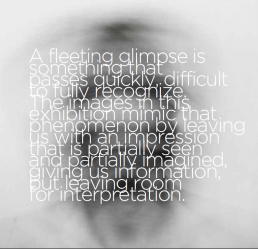The Fleeting Glimpse exhibition catalogue essay
Catalogue essay for “The Fleeting Glimpse: Selections in Modern and Contemporary Photography from the Virginia Museum of Fine Arts.” 2010. Perfect bound book. Full color printing. Co-distributed by the Virginia Museum of Fine Arts. 2011 ADDY Gold Award in Best Design and Best Editorial Cover.
The Eleanor D. Wilson Museum at Hollins University is pleased to present “The Fleeting Glimpse: Selections in Modern and Contemporary Photography from the Virginia Museum of Fine Arts,” featuring thirty-five works by twenty-seven artists using the photographic medium to transform common found occurrences in nature and humanity into unusual encounters and strange juxtapositions. “The Fleeting Glimpse” is the first major focus on the Virginia Museum of Fine Arts (VMFA)’s renowned photography collection and also marks the first partnership in collection sharing with the largest museum in the commonwealth. The exhibition roster encompasses a group of provocative legends of the camera, both modern and contemporary, and features the work of artists including Berenice Abbott, Diane Arbus, Blythe Bohnen, Judy Dater, Jen Davis, John Divola, Robert Doisneau, Martin Dorbaum, David A. Douglas, Roy DeCarava, Lee Friedlander, Ralph Gibson, Emmet William Gowin, John N. Heroy, Jr., Richard Kent Hough, Connie Imboden, Alen MacWeeney, Sally Mann,
Ralph Eugene Meatyard, Ray K. Metzker, Joseph Mills, Brian H. Peterson, Hiroshi Sugimoto, Ruth Thorne-Thomsen, Jerry N. Uelsmann, Garry Winogrand, and Willie Anne Wright.
Co-curator Christine Carr and I are fortunate to have access to a vast and diverse selection of photography from the Virginia Museum of Fine Arts. Given the keys to the kingdom, which consists of over one thousand photographs, making choices was a daunting task. As we culled through the wealth of possibilities, a unifying undercurrent began to emerge: the pursuit of a visually fragmented narrative. In the 1954 book Layman’s Guide to Modern Art: Painting for a Scientific Age, authors Mary C. Rathburn and Barlett H. Hayes, Jr. discuss the role of the camera in modern art: “The camera has expanded the visible horizon. It has halted what was fleeting and sharpened what was blurred.” 1 The notion of the camera’s ability to capture a fleeting image or temporal moment rang true. We began honing our selections to focus on artists exploring a variety of photographic styles such as street, tableau, deadpan, and portraiture (both posed and candid), as well as approaches including extended exposures, photomontage, and vignetting. The viewer has a “fleeting glimpse” of an implied alternative reality through the artists’ deliberate or sometimes happenstance staging and organization of chance elements. The resulting image is left open-ended for interpretation.
In the spirit of the “fleeting image,” the exhibition possesses several curatorial underpinnings that conjoin the works. A number of the artists including Hiroshi Sugimoto, Roy DeCarava, Martin Dorbaum, Brian H. Peterson, John Heroy, Jr., John Divola, and Willie Anne Wright create illusionary portals vis-à-vis windows, movie screens, garden slates, tents and even briefcases in their compositions to pull the viewer into their otherworldly voided spaces. Other works by Diane Arbus, Robert Doisneau, Judy Dater, Blythe Bohnen, Sally Mann, and Connie Imboden propel the viewer away through the sitters’ carefully staged gazes, controlled by the artist’s surface manipulations, transforming their features into
fractured and dissociated objects. The viewer is psychologically challenged to meet the subject’s confrontational stare. Other artists such as Robert Metzker, Lee Friedlander, and Garry Winogrand create a deliberate tension in their work between illusion and truth. One questions if the photographer happened upon the subject furtively or employed slippery visibility in capturing the image. And finally, artists such as Jerry Uelsmann, Joseph Mills, Ralph Eugene Meatyard, and Ruth Thorne-Thomsen entice us with implied psychosomatic drama through bizarre subject matter and compositions inviting further examination.
In “The Photograph as Contemporary Art,” Charlotte Cotton explores the notion of the “fleeting glimpse” as a pictorial tool evident in contemporary image making. Cotton comments, “The interplay of two- and three dimensional
spaces is one of the great pleasures of looking at photographs. The ability of the medium to depict solid plastic forms, fleeting events and combinations, and graphically reduce them to two dimensions, has been an enduring fascination and challenge to photographers throughout its history.”2 Cotton’s theory is proven in Brian H. Peterson’s exhibited archival pigment print Interior Light #5, as the image captures and transforms the variegated and shifting cyclical nature of light in intimate spaces. Through a chance event of a breeze blowing through a shuttered window before a bank of lights, the camera reinterprets the actual three-dimensional motion, curtain, and lights transforming each disparate element into an illusionistic illuminated flag. The final image is an exquisite metamorphosis from a fortuitous sequence of real time events to an imagined fleeting dreamscape. The frequently approachable medium of photography allows us the first “glimpse” of the exhibited artists’ impetus in achieving the ability to capture an untenable moment in history. Forever fleeting yet perpetually impregnated in paper, the selected artists’ work reminds us all to consider the eternal paradox of the photographic arts: is it truly seen or imagined?
1 Rathburn, Mary C. and Hayes Jr., Bartlett H. Layman’s “Guide to Modern Art: Painting for a Scientific Age.” (Massachusetts: Addison Gallery of American Art, Phillips Academy, 1954), 53.
2 Cotton, Charlotte. “The Photograph as Contemporary Art.” (London: Thames & Hudson Ltd., 1994), 39 – 41.

